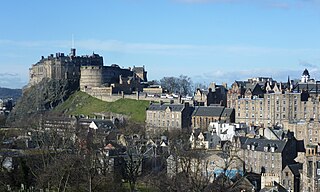
Edinburgh Castle is a historic castle in Edinburgh, Scotland. It stands on Castle Rock, which has been occupied by humans since at least the Iron Age. There has been a royal castle on the rock since at least the reign of Malcolm III in the 11th century, and the castle continued to be a royal residence until 1633. From the 15th century, the castle's residential role declined, and by the 17th century it was principally used as a military garrison. Its importance as a part of Scotland's national heritage was recognised increasingly from the early 19th century onwards, and various restoration programmes have been carried out over the past century and a half.
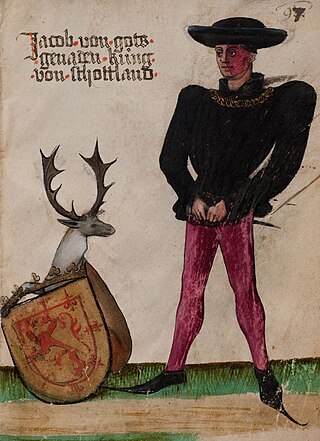
James II was King of Scots from 1437 until his death in 1460. The eldest surviving son of James I of Scotland, he succeeded to the Scottish throne at the age of six, following the assassination of his father. The first Scottish monarch not to be crowned at Scone, James II's coronation took place at Holyrood Abbey in March 1437. After a reign characterised by struggles to maintain control of his kingdom, he was killed by an exploding cannon at Roxburgh Castle in 1460.

Sir James Douglas was a Scottish knight and feudal lord. He was one of the chief commanders during the Wars of Scottish Independence.
Sir Alexander Ramsay of Dalhousie was a Scottish nobleman and knight who fought for David II, King of Scots in the south of Scotland in the Second War of Scottish Independence. He is remembered especially for his actions during the siege of Roxburgh Castle.

Threave Castle is situated on an island in the River Dee, 2.5 kilometres (1.6 mi) west of Castle Douglas in the historical county of Kirkcudbrightshire in the Dumfries and Galloway region of Scotland.
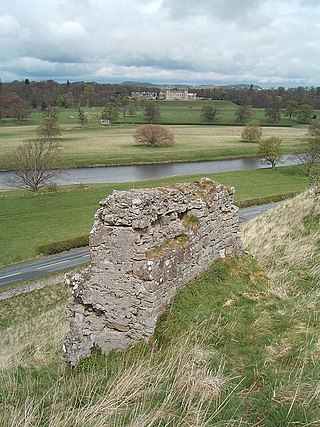
Roxburgh Castle is a ruined royal castle that overlooks the junction of the rivers Tweed and Teviot, in the Borders region of Scotland. The town and castle developed into the royal burgh of Roxburgh, which the Scots destroyed along with the castle after capturing it in 1460. Today the ruins stand in the grounds of Floors Castle, the seat of the Duke of Roxburghe, across the river from Kelso.
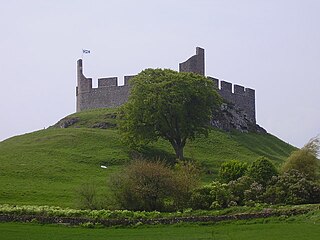
Hume Castle is the heavily modified remnants of a late 12th- or early 13th-century castle of enceinte held by the powerful Hume or Home family, Wardens of the Eastern March who became successively the Lords Home and the Earls of Home. The village of Hume is located between Greenlaw and Kelso, two miles north of the village of Stichill, in Berwickshire, Scotland.. It is a Scheduled Ancient Monument, recorded as such by Historic Environment Scotland.
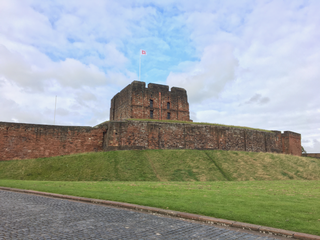
The siege of Carlisle occurred during the First English Civil War when the allied forces of the Scottish Covenanters and the English Parliamentarians besieged Carlisle Castle which was held at the time by the English Royalist forces loyal to King Charles I. The siege took place in Carlisle, Cumbria from October 1644 to 25 June 1645.
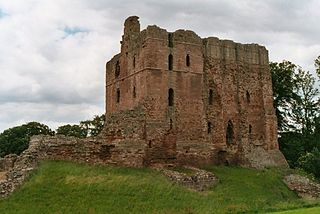
Norham Castle is a castle in Northumberland, England, overlooking the River Tweed, on the border between England and Scotland. It is a Grade I listed building and a Scheduled Ancient Monument. The castle saw much action during the wars between England and Scotland.

Sir William Douglas, Lord of Liddesdale, also known as the Knight of Liddesdale and the Flower of Chivalry, was a Scottish nobleman and soldier active during the Second War of Scottish Independence.
George Douglas, 4th Earl of Angus, Lord Douglas, Abernethy and Jedburgh Forest was a Scottish nobleman. He was the son of William Douglas, 2nd Earl of Angus and Margaret Hay of Yester. Known as the Great Earl of Angus. He succeeded to the Earldom following the death of his childless brother James Douglas, 3rd Earl of Angus in 1446. He was to become the first Red Chief of Douglas.

The siege of Berwick was an event in the First War of Scottish Independence which took place in April 1318. Sir James Douglas, Lord of Douglas took the town and castle of Berwick-upon-Tweed from the English, who had controlled the town since 1296.
The capture of Roxburgh was a siege that took place during the Anglo-Scottish Wars. James II of Scotland had started a campaign to recapture Roxburgh and Berwick from the English, while the rulers of England were occupied with the Wars of the Roses. King James would die during the siege being blown up by a cannon.
The Second War of Scottish Independence broke out in 1332, when Edward Balliol led an English-backed invasion of Scotland. Balliol, the son of former Scottish king John Balliol, was attempting to make good his claim to the Scottish throne. He was opposed by Scots loyal to the occupant of the throne, eight-year-old David II. At the Battle of Dupplin Moor Balliol's force defeated a Scottish army ten times their size and Balliol was crowned king. Within three months David's partisans had regrouped and forced Balliol out of Scotland. He appealed to the English king, Edward III, who invaded Scotland in 1333 and besieged the important trading town of Berwick. A large Scottish army attempted to relieve it but was heavily defeated at the Battle of Halidon Hill. Balliol established his authority over most of Scotland, ceded to England the eight counties of south-east Scotland and did homage to Edward for the rest of the country as a fief.
The Battle of Nesbit Moor was an engagement fought in August 1355 between forces of the Kingdom of Scotland and the Kingdom of England.

The Marian civil war in Scotland (1568–1573) was a period of conflict which followed the abdication of Mary, Queen of Scots, and her escape from Lochleven Castle in May 1568. Those who ruled in the name of her infant son James VI fought against the supporters of the Queen, who was exiled in England. Edinburgh Castle, which was garrisoned in her name, became the focus of the conflict and surrendered only after an English intervention in May 1573. The conflict in 1570 was called an "intestine war in the bowels of this commonwealth", and the period was called soon after an "intestine war driven by questions against authority."
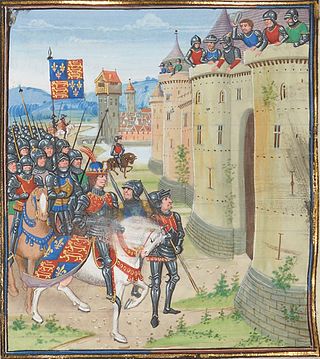
The siege of Berwick lasted four months in 1333 and resulted in the Scottish-held town of Berwick-upon-Tweed being captured by an English army commanded by King Edward III. The year before, Edward Balliol had seized the Scottish Crown, surreptitiously supported by Edward III. He was shortly thereafter expelled from the kingdom by a popular uprising. Edward III used this as a casus belli and invaded Scotland. The immediate target was the strategically important border town of Berwick.
The English invasion of Scotland of 1296 was a military campaign undertaken by Edward I of England in retaliation to the Scottish treaty with France and the renouncing of fealty of John, King of Scotland and Scottish raids into Northern England.
Burnt Candlemas was a failed invasion of Scotland in early 1356 by an English army commanded by King Edward III, and was the last campaign of the Second War of Scottish Independence. Tensions on the Anglo-Scottish border led to a military build-up by both sides in 1355. In September a nine-month truce was agreed, and most of the English forces left for northern France to take part in a campaign of the concurrent Hundred Years' War. A few days after agreeing the truce, the Scots, encouraged and subsidised by the French, broke it, invading and devastating Northumberland. In late December the Scots escaladed and captured the important English-held border town of Berwick-on-Tweed and laid siege to its castle. The English army redeployed from France to Newcastle in northern England.
The sieges of Berwick were the Scottish capture of the town of Berwick-upon-Tweed on 6 November 1355 and their subsequent unsuccessful siege of Berwick Castle, and the English siege and recapture of the town in January 1356. In 1355 the Second War of Scottish Independence had been underway for over 22 years. After a period of quiescence the Scots, encouraged by the French who were fighting the English in the Hundred Years' War, assembled an army on the border. In September a truce was agreed and much of the English army left the border area to join King Edward III's campaign in France.











